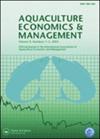Seaream和Seaass养殖场的技术效率和环境影响
IF 3.8
2区 经济学
Q1 AGRICULTURAL ECONOMICS & POLICY
引用次数: 17
摘要
摘要网箱养殖是地中海最重要的水产养殖形式。尽管全球水产养殖生产和需求持续增长,但Seaream和Seaass公司的经济表现并没有遵循同样的趋势。近年来,公司连续面临市场不稳定时期,供应和市场价格的高度波动严重影响了其运营利润率。尽管该行业具有地区重要性,但只有少数研究考察了这些农场的经济表现。本文研究了地中海养殖场的技术效率和规模效应。此外,还研究和讨论了农场养分排放对环境的影响。使用数据包络分析(DEA)分析技术效率效应,并使用bootstrap程序进行偏差校正。结果表明,平均技术效率可以提高16%至34%,规模效率表明,农场可以通过在最佳规模下运营来提高效率。与之前研究中的测量结果相比,环境变量表明,在过去20年中,养殖场每生产一公斤鱼的营养物质排放量没有变化。最后,政策影响表明,更多地关注提高技术效率可能有助于提高该行业的稳健性,可能需要进行环境监管,以提高农场的环境绩效。本文章由计算机程序翻译,如有差异,请以英文原文为准。
Technical efficiency and environmental impact of seabream and seabass farms
Abstract Sea cage farming of seabream and seabass is the most important form of aquaculture production in the Mediterranean Sea. Despite the continuous global growth in aquaculture production and demand, the economic performance of seabream and seabass companies has not followed the same trend. In recent years, companies have faced successive periods of market instability, with high volatility in supply and market prices that have strongly affected their operational margins. Despite the regional importance of this industry, only a handful of studies have examined the economic performance of these farms. In this paper, we investigate the technical efficiency and scale effects of Mediterranean aquaculture farms. Furthermore, environmental impact in terms of nutrient emissions from the farms is examined and discussed. Technical efficiency effects are analyzed using Data Envelopment Analysis (DEA), and the bootstrap procedure is used for bias correction. The results show that the mean technical efficiency could be improved by between 16% and 34%, and scale efficiency suggests that farms could improve their efficiency by operating at an optimal scale. Compared to measurements in previous studies, the environmental variables show that the emission of nutrients from the farms per kilo of fish produced has not changed over the past twenty years. Finally, policy implications suggest that more attention toward improving technical efficiency may help improve the robustness of the sector and that environmental regulation might be needed in order to improve the environmental performance of farms.
求助全文
通过发布文献求助,成功后即可免费获取论文全文。
去求助
来源期刊

Aquaculture Economics & Management
FISHERIES-
CiteScore
7.30
自引率
17.90%
发文量
21
期刊介绍:
Aquaculture Economics and Management is a peer-reviewed, international journal which aims to encourage the application of economic analysis to the management, modeling, and planning of aquaculture in public and private sectors. The journal publishes original, high quality papers related to all aspects of aquaculture economics and management including aquaculture production and farm management, innovation and technology adoption, processing and distribution, marketing, consumer behavior and pricing, international trade, policy analysis, and the role of aquaculture in food security, livelihoods, and environmental management. Papers are peer reviewed and evaluated for their scientific merits and contributions.
 求助内容:
求助内容: 应助结果提醒方式:
应助结果提醒方式:


